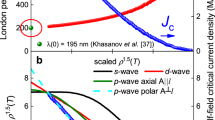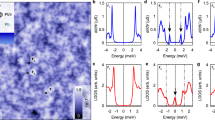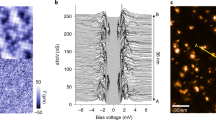Abstract
Although the possibility of spatial variations in the superfluid of unconventional, strongly correlated superconductors has been suggested1,2,3,4,5,6,7, it is not known whether such inhomogeneities—if they exist—are driven by disorder, strong scattering or other factors. Here we use atomic-resolution Josephson scanning tunnelling microscopy to reveal a strongly inhomogeneous superfluid in the iron-based superconductor FeTe0.55Se0.45. By simultaneously measuring the topographic and electronic properties of the superconductor, we find that this inhomogeneity in the superfluid is not caused by structural disorder or strong inter-pocket scattering and is not correlated with variations in the energy required to break electron pairs. Instead, we see a clear spatial correlation between the superfluid density and the quasiparticle strength (the height of the coherence peak) on a local scale. This result places iron-based superconductors on equal footing with copper oxide superconductors, where a similar relation has been observed on the macroscopic scale. Our results establish the existence of strongly inhomogeneous superfluids in unconventional superconductors, excluding chemical disorder and inter-band scattering as the causes of the inhomogeneity, and shed light on the relation between quasiparticle character and superfluid density. When repeated at different temperatures, our technique could further help to elucidate what local and global mechanisms limit the critical temperature in unconventional superconductors.
This is a preview of subscription content, access via your institution
Access options
Access Nature and 54 other Nature Portfolio journals
Get Nature+, our best-value online-access subscription
$29.99 / 30 days
cancel any time
Subscribe to this journal
Receive 51 print issues and online access
$199.00 per year
only $3.90 per issue
Buy this article
- Purchase on Springer Link
- Instant access to full article PDF
Prices may be subject to local taxes which are calculated during checkout




Similar content being viewed by others
Data and code availability
The data and code used in this work are available from the corresponding author upon reasonable request.
References
Emery, V. J. & Kivelson, S. A. Importance of phase fluctuations in superconductors with small superfluid density. Nature 374, 434–437 (1995).
Keimer, B., Kivelson, S. A., Norman, M. R., Uchida, S. & Zaanen, J. From quantum matter to high-temperature superconductivity in copper oxides. Nature 518, 179–186 (2015).
Fulde, P. & Ferrell, R. A. Superconductivity in a strong spin-exchange field. Phys. Rev. 135, A550–A563 (1964).
Larkin, A. I. & Ovchinnikov, Y. N. Nonuniform state of superconductors. Sov. Phys. JETP 47, 1136–1146 (1964).
Ghosal, A., Randeria, M. & Trivedi, N. Spatial inhomogeneities in disordered d-wave superconductors. Phys. Rev. B 63, 020505 (2000).
Feigel’Man, M. V. & Ioffe, L. B. Superfluid density of a pseudogapped superconductor near the superconductor-insulator transition. Phys. Rev. B 92, 100509 (2015).
Bouadim, K., Loh, Y. L., Randeria, M. & Trivedi, N. Single- and two-particle energy gaps across the disorder-driven superconductor-insulator transition. Nat. Phys. 7, 884–889 (2011).
Wang, F. & Lee, D. The electron-pairing mechanism of iron-based superconductors. Science 332, 200–204 (2011).
Božović, I., Wu, J., He, X. & Bollinger, A. T. What is really extraordinary in cuprate superconductors? Physica C 558, 30–37 (2019).
Ivanchenko, Y. M. & Zil’berman, L. A. The Josephson effect in small tunneling contacts. Sov. Phys. JETP 28, 1272–1276 (1969).
Ingold, G.-L., Grabert, H. & Eberhardt, U. Cooper-pair current through ultrasmall Josephson junctions. Phys. Rev. B 50, 395–402 (1994).
Naaman, O., Teizer, W. & Dynes, R. C. Fluctuation dominated Josephson tunneling with a scanning tunneling microscope. Phys. Rev. Lett. 87, 097004 (2001).
Hamidian, M. H. et al. Detection of a Cooper-pair density wave in Bi2Sr2CaCu2O8+x. Nature 532, 343–347 (2016).
Randeria, M. T., Feldman, B. E., Drozdov, I. K. & Yazdani, A. Scanning Josephson spectroscopy on the atomic scale. Phys. Rev. B 93, 161115 (2016).
Graham, M. & Morr, D. K. Imaging the spatial form of a superconducting order parameter via Josephson scanning tunneling spectroscopy. Phys. Rev. B 96, 184501 (2017).
Yin, Z. P., Haule, K. & Kotliar, G. Kinetic frustration and the nature of the magnetic and paramagnetic states in iron pnictides and iron chalcogenides. Nat. Mater. 10, 932–935 (2011).
Hanaguri, T., Niitaka, S., Kuroki, K. & Takagi, H. Unconventional s-wave superconductivity in Fe(Se,Te). Science 328, 474–476 (2010).
Miao H. et al. Universal 2Δmax/k B T C scaling decoupled from the electronic coherence in iron-based superconductors. Phys. Rev. B 98, 020502 (2018).
Homes, C. C. et al. FeTe0.55Se0.45: a multiband superconductor in the clean and dirty limit. Phys. Rev. B 91, 144503 (2015).
Bendele, M. et al. Anisotropic superconducting properties of single-crystalline FeSe0.5Te0.5. Phys. Rev. B 81, 224520 (2010).
Jäck, B. et al. A nanoscale gigahertz source realized with Josephson scanning tunneling microscopy. Appl. Phys. Lett. 106, 013109 (2015).
Ota, Y. et al. Ambegaokar–Baratoff relations for Josephson critical current in heterojunctions with multigap superconductors. Phys. Rev. B 81, 214511 (2010).
Liu, Z. K. et al. Experimental observation of incoherent-coherent crossover and orbital-dependent band renormalization in iron chalcogenide superconductors. Phys. Rev. B 92, 235138 (2015).
Singh, U. R. et al. Spatial inhomogeneity of the superconducting gap and order parameter in FeSe0.4Te0.6. Phys. Rev. B 88, 155124 (2013).
Feng, D. L. et al. Signature of superfluid density in the single-particle excitation spectrum of Bi2Sr2CaCu2O8+δ. Science 289, 277–281 (2000).
Kohsaka, Y. et al. How Cooper pairs vanish approaching the Mott insulator in Bi2Sr2CaCu2O8+δ. Nature 454, 1072–1078 (2008).
Ruan, W. et al. Visualization of the periodic modulation of Cooper pairing in a cuprate superconductor. Nat. Phys. 14, 1178–1182 (2018).
Dubi, Y., Meir, Y. & Avishai, Y. Nature of the superconductor–insulator transition in disordered superconductors. Nature 449, 876–880 (2007).
Bloch, I., Dalibard, J. & Zwerger, W. Many-body physics with ultracold gases. Rev. Mod. Phys. 80, 885–964 (2008).
Randeria, M. & Taylor, E. Crossover from Bardeen–Cooper–Schrieffer to Bose–Einstein condensation and the unitary Fermi gas. Annu. Rev. Condens. Matter Phys. 5, 209–232 (2014).
Sacépé, B. et al. Localization of preformed Cooper pairs in disordered superconductors. Nat. Phys. 80, 239–244 (2011).
Cao, Y. et al. Unconventional superconductivity in magic-angle graphene superlattices. Nature 556, 43–50 (2018).
Reyren, N. et al. Superconducting interface between insulating oxides. Science 317, 1196–1199 (2007).
Šmakov, J., Martin, I. & Balatsky, A. V. Josephson scanning tunneling microscopy. Phys. Rev. B 64, 212506 (2001).
Josephson, B. D. Possible new effects in superconductive tunneling. Phys. Lett. 1, 251–253 (1962).
Tinkham, M. Introduction to Superconductivity (McGraw-Hill, 1975).
Ambegaokar, V. & Baratoff, A. Tunneling between superconductors. Phys. Rev. Lett. 10, 486–489 (1963).
Tsuei, C. C. & Kirtley, J. R. Pairing symmetry in cuprate superconductors. Rev. Mod. Phys. 72, 969–1016 (2000).
Ng, T. K. & Nagaosa, N. Broken time-reversal symmetry in Josephson junction involving two-band superconductors. Europhys. Lett. 87, 17003 (2009).
Ota, Y., Machida, M., Koyama, T. & Matsumoto, H. Theory of heterotic superconductor–insulator–superconductor Josephson junctions between single- and multiple-gap superconductors. Phys. Rev. Lett. 102, 237003 (2009).
Seidel, P. Josephson effects in iron based superconductors. Supercond. Sci. Technol. 24, 043001 (2011).
Lin, S.-Z. Josephson effect between a two-band superconductor with s++ or s± pairing symmetry and a conventional s-wave superconductor. Phys. Rev. B 86, 014510 (2012).
Naaman, O. et al. Josephson effect in Pb/I/NbSe2 scanning tunneling microscope junctions. Int. J. Mod. Phys. B 17, 3569–3574 (2003).
Stewart, W. C. Current–voltage characteristics of Josephson junctions. Appl. Phys. Lett. 12, 277–280 (1968).
McCumber, D. E. Effect of ac impedance on dc voltage–current characteristics of superconductor weak-link junctions. J. Appl. Phys. 39, 3113–3118 (1968).
Nazarov, Y. V. & Ingold, G.-L. Charge Tunneling Rates in Ultrasmall Junctions Vol. 294, 21–107 (Springer, 1992).
Averin, D. V., Nazarov, Y. V. & Odintsov, A. A. Incoherent tunneling of the cooper pairs and magnetic flux quanta in ultrasmall Josephson junctions. Physica B 165–166, 945–946 (1990).
Jäck, B. et al. Critical Josephson current in the dynamical Coulomb blockade regime. Phys. Rev. B 93, 020504 (2016)
Ast, C. R. et al. Sensing the quantum limit in scanning tunnelling spectroscopy. Nat. Commun. 7, 13009 (2016).
Kimura, H., Barber, R. P., Ono, S., Ando, Y. & Dynes, R. C. Scanning Josephson tunneling microscopy of single-crystal Bi2Sr2CaCu2O8+δ with a conventional superconducting tip. Phys. Rev. Lett. 101, 037002 (2008).
Kimura, H., Barber, R. P., Ono, S., Ando, Y. & Dynes, R. C. Josephson scanning tunneling microscopy: a local and direct probe of the superconducting order parameter. Phys. Rev. B 80, 144506 (2009).
Ruby, M., Heinrich, B. W., Pascual, J. I. & Franke, K. J. Experimental demonstration of a two-band superconducting state for lead using scanning tunneling spectroscopy. Phys. Rev. Lett. 114, 157001 (2015).
Dynes, R. C., Narayanamurti, V. & Garno, J. P. Direct measurement of quasiparticle-lifetime broadening in a strong-coupled superconductor. Phys. Rev. Lett. 41, 1509–1512 (1978).
Anderson, P. W. in Lectures on the Many-Body Problem Vol. II (ed. Caianello E. R.) 113–135 (Academic Press, 1964).
Wang, Z. et al. Topological nature of the FeSe0.5Te0.5 superconductor. Phys. Rev. B 92, 115119 (2015).
Zhang, P. et al. Observation of topological superconductivity on the surface of an iron-based superconductor. Science 360, 182–186 (2018).
Mazin, I. I. & Singh, D. J. Comment on “Unconventional s-wave superconductivity in Fe(Se, Te)”. Preprint at https://arxiv.org/abs/1007.0047 (2010).
Hanaguri, T., Niitaka, S., Kuroki, K. & Takagi, H. Reply to comment on “Unconventional s-wave superconductivity in Fe(Se, Te)”. Preprint at https://arxiv.org/abs/1007.0307 (2010).
Moreschini, L. et al. Consequences of broken translational symmetry in FeSexTe1−x. Phys. Rev. Lett. 112, 087602 (2014).
Acknowledgements
We acknowledge J. C. Davis, S. D. Edkins, M. H. Fischer, K. J. Franke, H. Grabert, M. H. Hamidian, K. Heeck, M. Leeuwenhoek, D. K. Morr, M. T. Randeria, G. Verdoes and J. Zaanen for discussions. This work was supported by the European Research Council (ERC StG SpinMelt) and by the Netherlands Organization for Scientific Research (NWO/OCW), as part of the Frontiers of Nanoscience programme, as well as through a Vidi grant (680-47-536). G.D.G. is supported by the Office of Basic Energy Sciences, Materials Sciences and Engineering Division, US Department of Energy (DOE) under contract number de-sc0012704.
Reviewer information
Nature thanks Peter Wahl and the other, anonymous, reviewer(s) for their contribution to the peer review of this work.
Author information
Authors and Affiliations
Contributions
D. Cho, K.M.B. and D. Chatzopoulos performed experiments and data analysis. G.D.G. grew and characterized the samples. M.P.A. supervised the project and wrote the paper with input from all authors.
Corresponding author
Ethics declarations
Competing interests
The authors declare no competing interests.
Additional information
Publisher’s note: Springer Nature remains neutral with regard to jurisdictional claims in published maps and institutional affiliations.
Extended data figures and tables
Extended Data Fig. 1 Schematic of a Josephson tunnelling junction.
The Josephson junction consists of a Pb-coated platinum–iridium (Pt-Ir) tip and an atomically flat FeTe0.55Se0.45 surface, separated by a thin vacuum barrier. Inset, the Fe lattice is encapsulated by the chalcogen atoms selenium (Se) and tellurium (Te).
Extended Data Fig. 2 Various models used to describe Josephson tunnelling and their I–V characteristic curves.
a, Tilted-washboard potential U(Δϕ) for Ibias < IC. b, I–V curve calculated using the RCSJ model for Z(ω) = 0 and T = 0 K. The voltage drop is zero (dissipationless supercurrent) until Ibias > IC. c, Thermal phase fluctuations (illustrated by yellow dashed arrows) in the tilted-washboard potential. d, I–V and corresponding differential conductance dI/dV, calculated using the IZ model for Z(ω) = R and the phase-diffusive regime (ET > EJ). For the simulation we used RN = 1 kΩ and T = 2 K. e, Energy diagram of sequential inelastic Cooper pair tunnelling. f, I–V and differential conductance dI/dV, calculated using P(E) theory for a Z(ω) corresponding to the tip-induced antenna mode of energy hν = 200 μeV and the Coulomb blockade regime (ET < EC). The I–V and dI/dV curves in d and f correspond to a voltage of VB inside the gap.
Extended Data Fig. 3 Tunnelling spectra of Pt–Ir/Pb and Pb/Pb junctions.
a, Differential tunnelling spectra of a Pt–Ir/Pb junction with (blue dots) and without (red dots) electronic filtering using home-built lumped-element low-pass filters in series with commercial 1.9-MHz low-pass filters and grounding for all non-essential lines (Vset = +5 mV, Iset = 0.10 nA). We use a modified Dynes formula to fit our spectra, and the results give effective temperatures of 2.38 K (green line) and 2.20 K (yellow line). The other parameters are the same in both cases (ΔCP = 1.30 meV and γ = 50 μeV). b, Normalized conductance spectrum (blue curve) of a Pb/Pb junction, acquired with a junction resistance of 5 MΩ (Vset = +5 mV, Iset = 1.0 nA). The fit (red dashed curve) is consistent with the quasiparticle spectrum of a symmetric Josephson junction with a pair-breaking gap of 1.3 meV at 2.2 K.
Extended Data Fig. 4 Josephson tunnelling spectroscopy in a Pb/FeTe0.55Se0.45 junction.
a, b, RN-dependent I–V curves (see key in e). c, d, Corresponding RN-dependent dI/dV curves, multiplied by RN. The datasets are offset for clarity. For decreasing RN, the zero-bias peak and the small modulations (with a period of 0.1 meV) induced by Cooper pair tunnelling become more pronounced. e, Linear relation (black dashed line) between the critical Josephson current IC and the normal-state conductance, GN. Each point is the average of 20 points extracted from 20 I–V curves, as described in the main text. For each GN, we also extract the standard deviation of Imax and obtain the error bars shown in the figure by performing error propagation via the IZ formula. The red dashed line corresponds to the AB formula for a asymmetry Josephson junction in which two superconductor electrodes have the same s-wave symmetry with different pair-breaking gaps (ΔCP,t = 1.30 meV and ΔCP,s = 1.68 meV). f, Fitting (black curve) of a normalized conductance spectrum (red circles) using the IZ model. All dI/dV spectra are acquired with Vset = −10 mV and a lock-in modulation of Vmod = 20 μV peak to peak.
Extended Data Fig. 5 Superfluid density maps with inhomogeneous normal-state resistance.
a, b, Maps of the critical Josephson current IC. c, d, Spatial variations of the normal-state resistance, RN. e, f, Maps of (ICRN)2 associated with the superfluid density. The images in the left (right) column were acquired with a setup bias of −10 mV (+10 mV) and a setup current of 10 nA. To map the intrinsic superfluid density, it is necessary to normalize the measured IC by multiplying with RN. Topographs were acquired simultaneously with these measurements and used to align the different maps.
Extended Data Fig. 6 Determination of normal-state junction resistance, RN.
a, RN-dependent differential conductance curves, dI/dV (see key in c). For the normal-state conductance GN, we use average values of dI/dV over the full energy range. The GN values are indicated with the dashed lines and labels. b, RN-dependent I−V curves acquired simultaneously with dI/dV. c, The I−V curves multiplied with RN. All of the curves coincide. All spectra were acquired with Vset = −10 mV and a lock-in modulation of Vmod = 100 μV peak to peak.
Extended Data Fig. 7 Quasiparticle interference induced by inter-pocket scattering in FeTe0.55Se0.45.
a, Top-view of the atomic structure of FeTe0.55Se0.45. The blue and red spheres denote the chalcogen and the transition metal atoms, respectively. b, Fermi surface of FeTe0.55Se0.45. Two hole pockets are at the Γ point and one electron pocket at the M point, marked by black circles and ellipses. The red (blue) dashed lines correspond to the reciprocal lattice of Fe (chalcogen) layer. Because the unit cell includes two Fe atoms, the Brillouin zone of Fe (red square) atoms is two times larger than that of the full crystal structure (blue square). The alternate vertical positions of the chalcogen atoms above and below the Fe layer lead to a folded band (grey ellipse centred at the M point) composed of out-of-plane d orbitals59. Here we highlight the inter-pocket scattering wavevectors with black, yellow and red solid arrows. c, Sketch of scattering wavevectors in the reciprocal lattice. The colour coding is identical to that in b. d, Stripy patterns in a dI/dV map at +3.9 meV induced by inter-pocket scattering (Vset = −10 mV, Iset = 20 nA and Vmod = 200 μV peak to peak). e, FFT spectrum of quasiparticle interference patterns. The circles correspond to the inter-pocket scattering wavevectors in b with the same colour coding.
Extended Data Fig. 8 Determination of quasiparticle interference strength.
a, dI/dV map at VB = +3.6 meV (shown in Fig. 3d). b, Band-pass-filtered FFT (not symmetrized) spectrum. c, Inverse FFT map of the filtered spectrum in b. d, Amplitude map of inter-pocket scattering pattern. The amplitude is determined by smoothing the filtered image in c. The red contours correspond to the mean amplitude of the map.
Extended Data Fig. 9 Correlation plots between superfluid density and various parameters.
a–d, Correlation between superfluid density and pair-breaking gap (a); strength of quasiparticle interference (b); topographic height (c) and quasiparticle strength minus the normal-state conductance (d; see inset), which gives similar results to those obtained without subtracting the normal conductance, as in the main text.
Extended Data Fig. 10 Suppression of superfluid density at the atomic scale.
a, b, Topograph (a) and superfluid density map (b). To highlight the atomic-scale variation of the superfluid density, we show the magnified map centred at the atomic defect (marked by a red and white arrow). Same data as in Fig. 3a, b.
Rights and permissions
About this article
Cite this article
Cho, D., Bastiaans, K.M., Chatzopoulos, D. et al. A strongly inhomogeneous superfluid in an iron-based superconductor. Nature 571, 541–545 (2019). https://doi.org/10.1038/s41586-019-1408-8
Received:
Accepted:
Published:
Issue Date:
DOI: https://doi.org/10.1038/s41586-019-1408-8
This article is cited by
-
Phase and stoichiometry control in superconducting FeSe layers on SrTiO3
Journal of Materials Science (2024)
-
Superconducting tunnel junctions with layered superconductors
Quantum Frontiers (2024)
-
Single-electron charge transfer into putative Majorana and trivial modes in individual vortices
Nature Communications (2023)
-
Pair density wave state in a monolayer high-Tc iron-based superconductor
Nature (2023)
-
Preparation of spatially uniform monolayer FeSexTe1−x (0 < x ≤ 1) by topotactic reaction
Nano Research (2023)
Comments
By submitting a comment you agree to abide by our Terms and Community Guidelines. If you find something abusive or that does not comply with our terms or guidelines please flag it as inappropriate.



